Black Sea Shipyard: TAKR Riga - Leonid Brezhnev
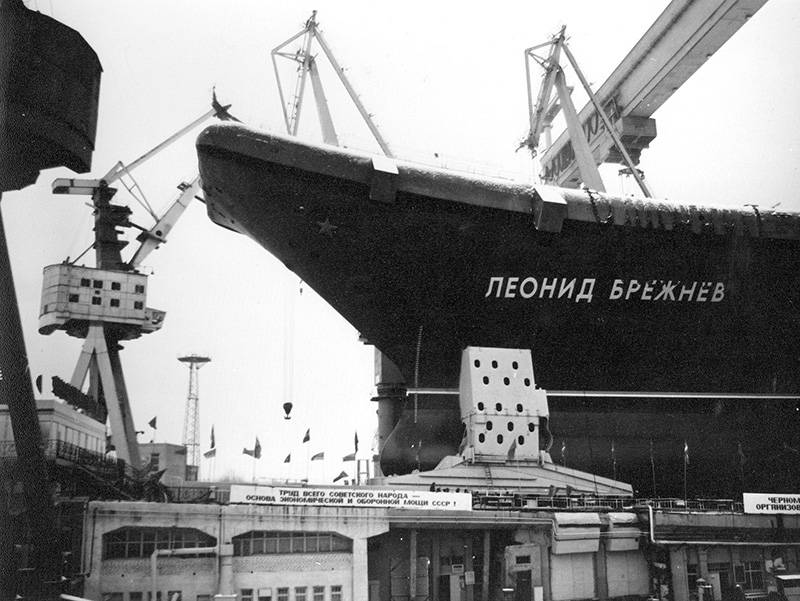
"Battle" for an aircraft carrier
Throughout the 70s. in the military environment did not stop the struggle for the appearance of this class of ships in the Soviet navy. Defense Minister Grechko and Fleet Commander Admiral Gorshkov advocated the construction of aircraft carriers armed with horizontal take-off and landing aircraft. Their opponents were Marshal Ogarkov, Chief of the General Staff, and Ustinov, Secretary of the Central Committee for Armaments (and future Minister of Defense of the USSR). By the mid 70's. the scales began to lean toward a group of supporters of the development of the carrier fleet, but the death of first Marshal Grechko, and then the Minister of Shipbuilding Boris Butoma, who also advocated the construction of these ships, made adjustments.
It was decided to abandon the projects of the 1160 ships and its reduced version of the 1153 cipher "Eagle" in favor of the gradual development of heavy aircraft-carrying cruisers 1143. In the autumn of 1977, the Nevskoye PKB was ordered to develop a technical proposal, and the research institutes of the Air Force and Navy received technical specifications for the development of a ship equipped with aerofinishers and catapults. His air group along with the VTOL and helicopters had to consist of aircraft horizontally taking off and landing.
A promising heavy aircraft-carrying cruiser was supposed to give stability to the naval connections of the Soviet fleet in remote regions of the oceans, to provide cover for the deployment and patrol areas of nuclear submarines, destroy surface and air targets. If necessary, strike on coastal objects.
Neva PKB, having worked hard, issued to the surface five variants of technical proposals. One of them involved the construction of a ship with an atomic power plant. For further work, the smallest displacement variant was recommended, which had a boiler-turbine power plant and was equipped with one steam catapult. His air group was to consist of MiG-18, Su-28 or Yak-29 and 27 helicopters of 141 – 14 aircraft.
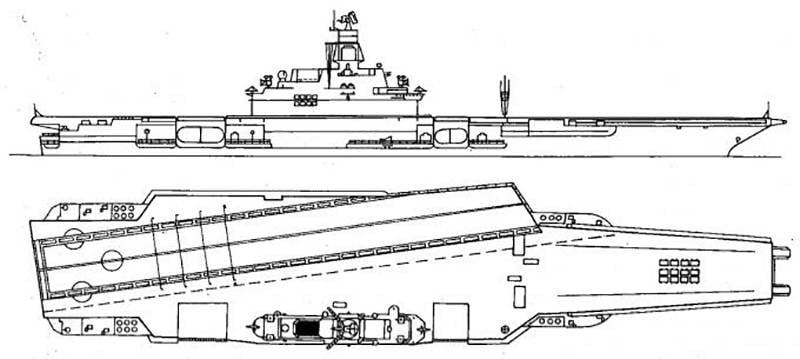
After the corresponding decree of the Council of Ministers in October 1978, the full-scale design of the new ship began. As has already been the case on several occasions, the forming and final draft has been constantly amended and recommended, often contradictory. In the summer of 1979, the town of Gorshkov demanded that the designers of the Nevsky PKB strengthen the anti-aircraft armament of the ship. At the end of autumn, a proposal to increase the air group was made to the draft already approved for final consideration.
The problem was that the main dimensions of the ship were limited by the length of the stocks of the Black Sea Shipbuilding Plant and the Northern Dry Dock in Sevastopol, and Gorshkov’s proposal on the air group immediately increased the standard draft displacement to 65 thousand tons, which was greeted with hostile opponents. In aggravated contradictions, Marshal Ustinov, at the beginning of 1980, signed a directive proposing to reduce the displacement by 10 thousand tons and abandon the catapult. Takeoff from the deck was to be carried out from a springboard. The air group was supposed to be 40 aircraft and helicopters.
Certain danger for carrier ships lurked in the work begun as early as 1977 on the initiative of the Deputy Chief of the General Staff Admiral Nikolai Nikolayevich Amelko on the landing helicopter carrier of the 10200 "Halzan" project, which the Chernomorsudoproject Nikolaev was engaged in. It was based on the 1609 container ship “Atlantic” with a gas turbine power plant, which the Black Sea Shipyard built in those years.
With a draft displacement of 30 thousand tons, this helicopter carrier had to carry from 14 helicopters in the landing version to 28 in the anti-submarine. In addition, the landing option involved placing on board about 50 tanks and a battalion of marines. Such ships were considered by Admiral Amelko as a cheap alternative to specially built aircraft carriers. They were to be built in Nikolaev, at the Black Sea plant, after the ships of Project 1143.
A struggle broke out around two actually competing vectors for the development of aircraft carriers in the Soviet fleet, in which not only military departments were involved, but also the military-industrial complex. In the end, in 1980, Gorshkov and his supporters were able to keep the direction of heavy aircraft-carrying cruisers equipped with a springboard, and they decided to abandon the Halzan project. However, the "carrier-based" battles at the top did not go unnoticed for the entire development program.
As a result, the design period of the new heavy aircraft-carrying cruiser was shifted by two years, as well as the beginning of its construction. While at the top they decided once again whether to be or not to be an aircraft carrier, and if to be, how much, the Black Sea Plant worked on the construction of the fourth ship of the 1143.4 project "Baku". He was supposed to be launched in 1982 year, and on the vacant space and planned to lay a new heavy aircraft carrier with a springboard and aerofinishera.
Design work
The draft design of the new ship was ready for the 1980 summer, but at that moment the conditions and requirements of the customer changed once again, and the project was not approved. Changes and recommendations fell as if from a horn of plenty - the composition and number of the air group were constantly changing. Corrected in the direction of increasing anti-aircraft missile weapons: planned to install 8 fire modules of the anti-aircraft artillery complex "Dirk". On the deck it was supposed to place four cable arresting equipment and an emergency barrier. The shock anti-ship complex "Basalt" also "moved" several times from place to place. Its presence remained an integral part of the project.
The requirements for a future aircraft carrier were strict. When the desired was finally embodied on paper, it turned out that it was impossible to keep within the allotted displacement limit, besides, “cut off” by Ustinov. In the autumn of 1981, the city of Ustinov gave the go-ahead to increase the displacement by 10 th. Tons, which made it possible to significantly improve the project. Air Group expanded to 50 aircraft. Instead of "Basalt" it was decided to arm the ship with a more sophisticated complex "Granit", the launchers of which were located below the deck.
The question of the possibility of taking off the MiG-29 and Su-27 airplanes from the springboard was promised by the relevant departments to work out carefully. In 1982, a unique complex (later NITKA) was commissioned in the Crimea, where the development of take-off and landing on the deck of an aircraft-carrying cruiser began. The Black Sea Shipyard took direct part in the creation of this complex. Its construction began in 1977 near the village of Novofedorovka, Saksky district in the Crimea.
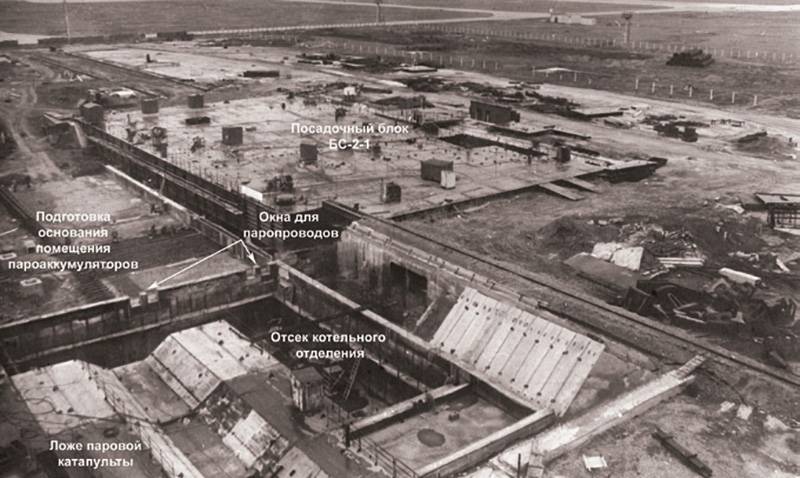
The idea of creating such an object arose in the mid-70s, when active design work was underway on aircraft carriers 1153 code "Eagle". An additional incentive for the emergence of the future NITKA complex (Ground Test Training Complex Aviation) was a visit by Admiral Gorshkov during his visit to the United States the American Lakehurst complex in New Jersey. Now in Crimea, a ground-based analogue of the future aircraft carrier was created with all the associated attributes: aerofinisher, take-off springboard and catapult. All take-off and landing blocks with a total mass of 12 thousand tons were made at the Black Sea plant, and then transported by sea to Novofedorovka, where the final assembly and assembly took place. All construction work at the facility was supervised by the senior builder of the Black Sea Plant, Aleksey Ivanovich Seredin.
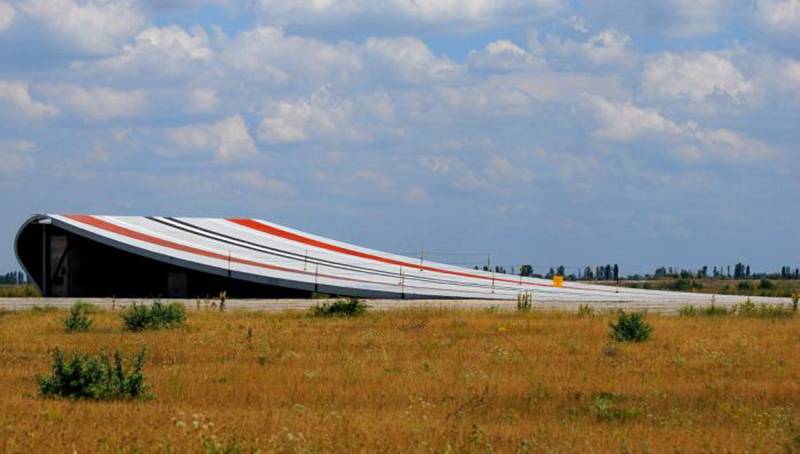
Considering the springboard as a successful and last but not least cheaper substitute for a catapult, the General Staff ordered that all design work on it, which had been going on since 1972, be stopped. This decision was controversial, because, despite all the seeming advantages of the springboard, the ejection take-off has its advantages.
The future ship was planned to be equipped with onboard underwater constructive protection against torpedo explosions - a large design and research work was carried out. For practical tests at the Black Sea Plant, two compartments weighing 450 tons each were manufactured, which were then welded to the tank of the Kazbek tanker (also built by CSV) and tested in explosions. By March 1982, work on the project was generally completed, and 7 in May of that year was officially approved by a decision of the USSR Council of Ministers. He received the digital designation 1143.5.
Building
September 1 1982 on the “zero” stocks of the Black Sea Plant was laid order number XXUMX, the fifth in a row heavy aircraft carrier of the project 105. The commander-in-chief of the USSR Navy admiral of the fleet of the Soviet Union Sergey Gorshkov arrived at the laying ceremony in Nikolaev. Originally it was called "Riga". However, after the death of Leonid Ilyich Brezhnev, General Secretary of the Central Committee of the CPSU, 1143.5 November 10 of the year 1982 November "Riga" was renamed "Leonid Brezhnev".
The construction of the hull was already carried out using the “block” method. In September, the bottom sections were installed on the slipway, and in December, the assembly of blocks on the pre-assembly site began. 26 February 1982. The first unit has already been installed on the slipway. According to the plan, the ship hull was to be assembled from 24 blocks, each weighing 1400 tons. The construction schedule was tough: complex drawings for each unit were produced monthly, and in total for all specializations.
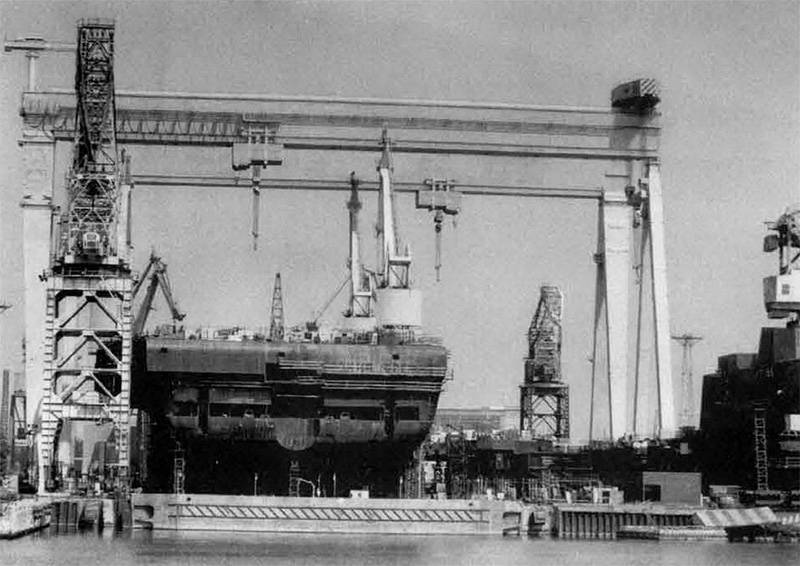
Two 900-ton cranes of the KONE company, which were controlled from a single master crane console, allowed this scheme to work synchronously and accurately, which made it possible to install 1400 tons of blocks on the slipway and almost immediately start welding the assembly seam. From the assembly and welding shop №11, where the sections comprising the future block were welded, metal structures were delivered to the pre-platform site of the zero stocks by special trailers. These machines manufactured by the Finnish company Hollming were received by the plant from the Baltic Shipping Company in the framework of equipment exchange. Each of these trailers (workers nicknamed them "centipedes") was able to transport structures weighing up to 350 tons.
About 1143.5, thousands of enterprises of the entire Soviet Union, took part in the creation of the heavy aircraft-carrying cruiser of the 3,5 project. Electronic computers of the Black Sea Shipyard and Nevsky PKB were connected by a communication line by telephone cable, forming a single system that allows you to process a huge amount of design documentation. This approach greatly facilitated the construction and installation work - on the stocks, they had already begun cable installation. The formation of the hull went simultaneously in two directions from the mortgage block - to the bow and stern and at the same time upwards.
Of the entire rather significant range of weapons provided by the project, a block of launchers of the Granit complex was mounted during the slip-way period. In order not to please the probable enemy reconnaissance satellite into the “photo session”, the launchers were assembled secretly, and the ship was being loaded onto the ship under construction at night.
In 1985, the Leonid Brezhnev was already being prepared for launching. The ship of such a mass was lowered for the first time at the enterprise, for which the necessary preparatory work was done. For a more even distribution of the load, they decided to descend the order on four lanes. Such in the domestic shipbuilding was carried out for the first time. Decades earlier, it was planned to descend the battleship Sovetskaya Ukraine in a similar way, but this ship was never completed.
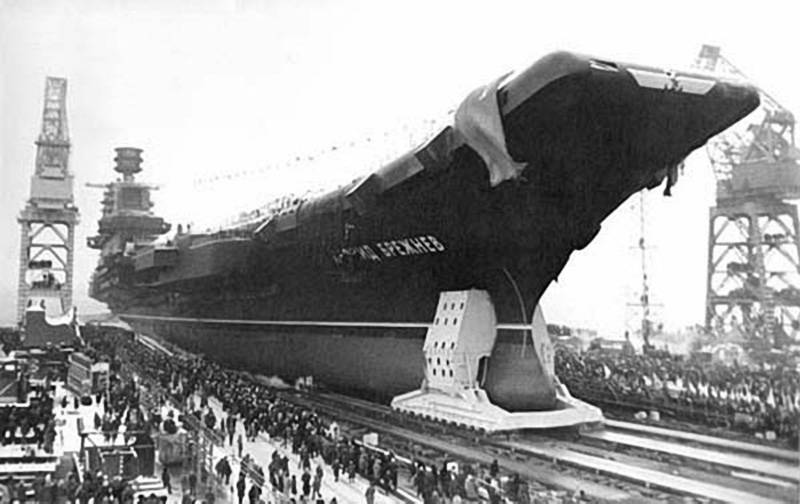
December 4 The Leonid Brezhnev 1985 was solemnly launched. The next day, it was moored at the North Embankment of the Great Bucket for completion. Ahead of the new Soviet heavy aircraft carrying cruiser waited for numerous new equipment, a new name and an extensive range of tests.
To be continued ...
Information